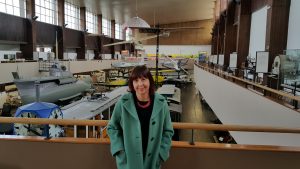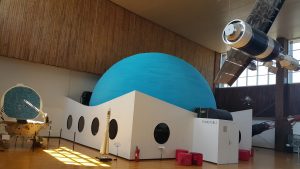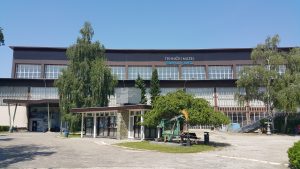Nikola Tesla Technical Museum is engaged in popularization of science, and is hereby inviting visitors to participate in its experiments.„The museum constantly creates new content, both formal and informal, which makes it one of the most popular museums in Zagreb and Croatia. With the availability of the EU funds, the museum will become even more attractive, both spatially and content-wise“, says Markita Franulić, Curator of Nikola Tesla Technical Museum, for Diplomacy&Commerce magazine.

-
1.Year-on-year, Nikola Tesla Technical Museum has been one of the most popular museums in Zagreb and Croatia. Why is that so?
The great popularity of the museum is based on many years of successful work in organizing visits and cooperating with schools and travel agents. The education component of the museum is today realized through various types of formal and informal content, informative guided tours, method units, lectures, seminars and practicums, as well as through demonstrations and experiments for school children and visitors of diverse profiles and ages. The experimental and didactic activity of the museum comprises of conducting demonstrations and experiments, where visitors acquire knowledge through their own experience and participation. Informative guide tours are part of our regular free services for all groups, and for individual visitors during special hours. We also have daily guided tours and demonstrations which are held in the spectacular-looking mine, the Nikola Tesla Demonstration Cabinet, and the planetarium.
-
Both the museum exhibits and buildings tell an interesting story, and are all considered cultural heritage. Could you tell us more about the history of the buildings and their reconstruction stages?
The museum buildings were built in 1949, and Marijan Haberle is the architect who designed the original building which was erected opposite the old building of the Zagrebački Zbor in 25, Savska Street, originally as an extension of the exhibition area of the Zagreb Fair. After the Fair relocated, the complex was assigned to the Museum in 1959. The re-mapping and adaptation of the exhibition area into museum space was done by architect Marijan Haberlem, the designer of the original building. This is a complex of wooden urban architectural structures which, together with the yard, are declared immovable cultural heritage and are listed in the Croatian Cultural Heritage Register.

-
How much is the name of Nikola Tesla a magnet for foreign visitors, and what is there to see in this great scientist’s cabinet which is a part of the museum exhibition?
The museum bears Nikola Tesla’s name since 2015, in honour of one of the true science bard. In the last few years, we have noticed an increase in the number of foreign visitors, and the name Nikola Tesla is definitely to blame for that. The museum equipped Nikola Tesla’s Demonstration Cabinet back in 1976, and refurbished it in 2016. This is one of the biggest attractions in the museum. Every day, in the cabinet, we stage a dozen or so experiments involving Tesla’s rotary magnetic field, high frequency currents, wireless transmission of electromagnetic titers, remote controlled boat, the Tesla turbine and others. We also invite visitors to actively participate in some of these experiments.

-
How important are technical innovations today in bringing the museum closer to the public, and what can the museum offer to future visitors in this respect?
Unfortunately, our museum does not utilize numerous technical innovations in its presentation. Although, we have interactive exhibits in our Renewable Energy Resources and Energy Efficiency Department, and touch screens in the Energy Transformation Department, our dominant way of presenting the exhibits is the old-fashioned one. Some exhibits are so old and have museological and historic value so we will try to preserve that in the future too.
The museum has to draft a concept and put together new permanent exhibitions along with increasing the number of interactive exhibits. However, speaking from our experience, having a guide taking you through the museum still plays a big role. Considering that our museum presents original historic material, both the equipment and technology used in presentation have to be in the service of providing additional information about that material. We have also drafted a project called ‘The Experiment Park’, and have made a proposal to the city government to make the park as an extension of the museum that would be located in the same complex as the Tesla Tower.
-
Which exhibitions in the museum are the most popular among your youngest visitors?
Young visitors are particularly interested in the exhibits in the Traffic Department, as well as in our life-size model of coal and metal ore mine right in the heart of the city, located a few hundred meters below the museum, which faithfully depicts the mining in the 20th century Croatia. Visiting the mine is something that they will remember forever. We often hear that from our visitors.
In Astronautics, we have the models of spacecrafts, rockets and orbital stations used in the exploration of the Universe, and in the planetarium, which can take up to eighty visitors, we give lectures and showcase a realistic version of the starring sky. A permanent exhibition devoted to renewable sources and energy efficiency, as well as a reinstated nuclear power plant exhibit and an information corner dedicated to radioactive waste all cover current issues and social, technological and general social issues.
-
How important is for the museum to have access to European funds, and how can they help in introducing new content?
In October, after a year and a half of a painstaking project evaluation and drafting, we signed an agreement on an EU grant worth around 2.5 million kunas. This money will be spent on drafting project documentation for interior refurbishment of our Hall B, and introduction of new content – a permanent new communication exhibition, innovation exhibition and the exhibition about Croatia’s contribution to scientific and technological achievements. We have also applied for funds with our culture programme dedicated to the integration of the citizens born in 1954 and later.
7. To what extent can the museum count on the assistance from the City of Zagreb in implemenation of its ambitious modernization plans?
The City of Zagreb finances and conducts the museum’s refurbishment. The city is also our partner in the EU-funded project on drafting of project documentation for the reconstruction of the infrastructure, and the introduction of new content and services in the Hall B and in the museum’s courtyard. Our design proposal for the Hall V, which is a separate building that would serve as an outdoor depot, a restoration and preparatory workshop, an exhibition area, a caffé and a media lab, has been included in the City’s indicative list of investments financed from the EU funds through the ITI mechanism (Integrated Territorial Investments). The Hall V would definitely liven up the surrounding city areas.